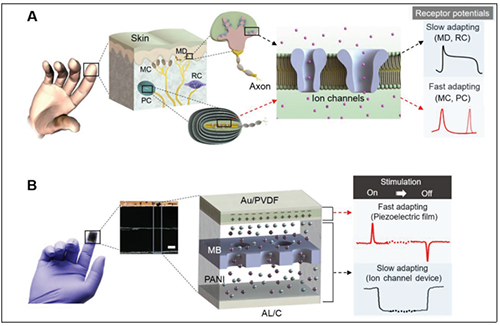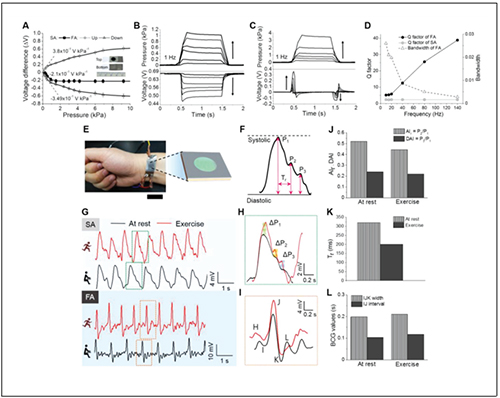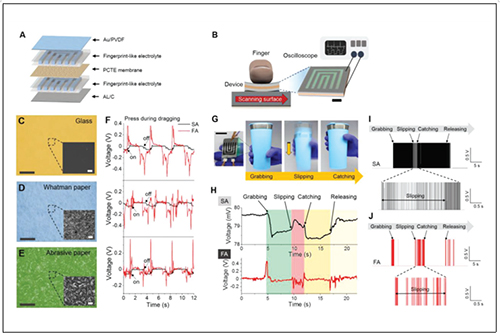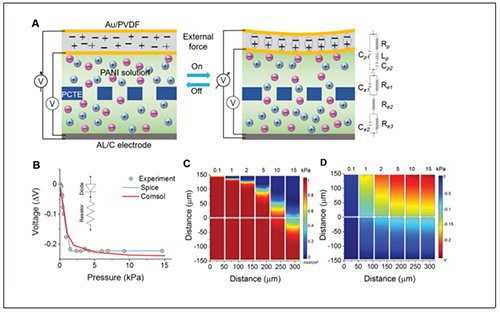Prof. Chang-Soo Han develops self-powered, ultra-high precision artificial skin sensor
Operates based on ion channels unlike silicon devices
Published in Advanced Materials

▲ Prof. Chang-Soo Han, Department of Mechanical Engineering, College of Engineering
Professor Chang-Soo Han of the Department of Mechanical Engineering, under the College of Engineering, developed a self-powered, ultra-high precision artificial skin sensor that closely mimics the function of human skin.
* Artificial skin sensor: A sensor that measures pressure, vibration, and touch produced from external physical stimuli
The results were published in the international journal Advanced Materials on February 9.
※ Title of Article: A Self-Powered Sensor Mimicking Slow- and Fast-Adapting Cutaneous Mechanoreceptors
※ Authors: Prof. Chang-Soo Han (corresponding author, Korea University), Prof. Kyoung-Yong Chun (first author, Korea University)
High-sensitivity sensors have been in the spotlight as a result of the widespread use of pressure and touch sensors in various fields such as healthcare, automobiles, aircrafts, household appliances, and the environment. However, currently available sensors have low sensitivity and high power consumption. The self-powered skin sensor developed by Professor Han operates based on signals delivered with the transport of ions under external stimuli. By measuring both fast- adapting and slow-adapting signals, the device offers high precision in detecting blood pressure, ballistocardiogram, and surface characteristics of an object, as well as braille.
* Fast-adapting: Response signals generated immediately at the start and end of stimuli
* Slow-adapting: Response signals generated continuously from the start to end of stimuli
Professor Han said, “The device relies on ion channels instead of silicon, creating a new paradigm for artificial sensors. The results are expected to enhance biosignal measurement and robot skin function, and the establishment of a self-powered high-sensitivity monitoring system will have diverse industrial applications.”
The study was conducted under the Basic Science Research Program (individual/group research) and the Global Frontier Project supported by the Ministry of Science and ICT.
[Terminology]
1. Advanced Materials
Advanced Materials is a leading scientific journal that has been published since 1989. Thomson JCR rated it as belonging to the top 1.37% (impact factor 19.79) of journals in the field of chemistry and physics.
2. Ion channel
Ion channels are pore-forming membrane proteins that transport ions or water molecules across the cell membrane. The human sensory system is comprised of receptors for stimuli detection and ion channels. The transport of ions in ion channels produces signals, which are transmitted to the brain through the axon.
3. Artificial skin sensor
A sensor that measures pressure, vibration, and touch produced from external physical stimuli.
4. Fast-adapting, slow-adapting
Fast-adapting is when response signals are generated immediately at the start and end of stimuli, while slow-adapting is when response signals are generated continuously from the start to end of stimuli.
5. Receptor
Receptors are structures that react to external stimuli and trigger ion channels by physical or chemical means. The body contains various types (chemical, physical, mechanical) of receptors for different stimuli.
6. Electrolyte
Electrolytes are a substance that separates into ions when dissolved in a solvent in order to facilitate current flow. In this study, three types of electrolytes were used to demonstrate the diverse characteristics of the pressure sensor.
7. Skin pressure sensor
A sensor that measures pressure generated from external physical contact in the unit of Pa (Pascal). In this study, pressure was measured at low power for a small applied-pressure range (<1 kPa), and without power for a general range (100–10,000 Pa).
[Figure Description]

Figure 1: Schematics of a biological somatosensory system and an artificial skin sensor signal mechanoreceptor cutaneous sensor
(A) Four mechanoreceptors in the human skin and two types of receptor signals produced through ion channels (Slow-adaption: Merkel disk, MD and Ruffini cylinder, RC. Fast-adaption: Meissner corpuscle, MC and Pacinian corpuscle, PC)
(B) Cross-section and structure of the artificial cutaneous sensor. Slow-adaption: Signal generated within ion channels. Fast-adaption: Signal generated at the piezoelectric film. Operates as a single system when pressure is applied. (Scale bar: 100 micrometer).

Figure 2: Pressure sensation characteristics of artificial skin sensors
(A) Pressure change and sensitivity measured using an oscilloscope while applying pressure
(B) Slow-adaption curve under various applied pressures
(C) Fast-adaption curve under various applied pressures
(D) Mechanical Q factor of the two response signals and bandwidth graph of fast-adaption obtained from vibration response
(E) Artificial skin pressure sensor attached to the wrist in order to measure blood pressure signals
(F) Typical radial artery measurements
(G) Changes in fast-adaption and slow-adaption signals when resting after exercise
(H) Analysis of pulse wave signals for slow-adaption
(I) Ballistocardiogram curve for fast-adaption
(J) Radial artery augmentation index and radial diastolic augmentation index obtained from pulse signals produced at the wrist
(K) Round-trip time of slow-adaption measured from the wrist
(L) Comparison of ballistocardiogram values of IJK width and IJ interval

Figure 3: Texture and grasping sensation of artificial skin sensors
(A) Schematic of fingerprint-shaped sensor structure
(B) Measurement using the fingerprint-shaped sensor. Scale bar: 5 mm. Line pattern width: 2 mm.
(C) Optical image of glass surface
(D) Optical image of Whatman paper
(E) Optical image of abrasive paper
(F) Simultaneous measurement of fast-adaption and slow-adaption on each surface
(G) Photographs of a fingerprint-type sensor when a tumbler is dropped by the hand and then caught again
(H) Fast-adaption and slow-adaption signals generated from the tumbler grabbing state to the release state
(I) Frequency-voltage conversion signal for slow-adaption
(J) Frequency-voltage conversion signal for fast-adaption

Figure 4: Operating mechanism and simulation results of artificial skin sensors
(A) Schematic illustration of sensing mechanism. Voltage generation in PVDF film and voltage measurement in the ion channels. Circuit diagram comprised of piezoelectric film, ion channels, and electrodes.
(B) Sensing results simulated using Comsol and Spice
(C) 2D ion distribution simulated using Comsol while applying pressure
(D) 2D distribution of potential change simulated using Comsol. Driven pressure range: 0.1–15 kPa.



